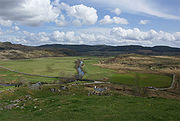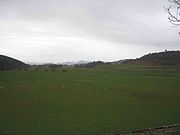
Kilmartin Glen
Encyclopedia

Argyll
Argyll , archaically Argyle , is a region of western Scotland corresponding with most of the part of ancient Dál Riata that was located on the island of Great Britain, and in a historical context can be used to mean the entire western coast between the Mull of Kintyre and Cape Wrath...
not far from Kintyre
Kintyre
Kintyre is a peninsula in western Scotland, in the southwest of Argyll and Bute. The region stretches approximately 30 miles , from the Mull of Kintyre in the south, to East Loch Tarbert in the north...
, which has one of the most important concentrations of Neolithic
Neolithic
The Neolithic Age, Era, or Period, or New Stone Age, was a period in the development of human technology, beginning about 9500 BC in some parts of the Middle East, and later in other parts of the world. It is traditionally considered as the last part of the Stone Age...
and Bronze Age
Bronze Age
The Bronze Age is a period characterized by the use of copper and its alloy bronze as the chief hard materials in the manufacture of some implements and weapons. Chronologically, it stands between the Stone Age and Iron Age...
remains in Scotland
Scotland
Scotland is a country that is part of the United Kingdom. Occupying the northern third of the island of Great Britain, it shares a border with England to the south and is bounded by the North Sea to the east, the Atlantic Ocean to the north and west, and the North Channel and Irish Sea to the...
. The glen is located between Oban
Oban
Oban Oban Oban ( is a resort town within the Argyll and Bute council area of Scotland. It has a total resident population of 8,120. Despite its small size, it is the largest town between Helensburgh and Fort William and during the tourist season the town can be crowded by up to 25,000 people. Oban...
and Lochgilphead
Lochgilphead
Lochgilphead is a town and former burgh in Scotland, with a population of around 3,000 people. It is the administrative centre of Argyll and Bute. The town lies at the end of Loch Gilp and lies on the banks of the Crinan Canal....
, surrounding the village of Kilmartin
Kilmartin
Kilmartin is a small village in Argyll and Bute, western Scotland. It is best known as the centre of Kilmartin Glen, an area with one of the richest concentrations of prehistoric monuments and historical sites in Scotland. It contains over 350 monuments within a 6 mile radius.-Kilmartin Parish...
.
There are more than 350 ancient monuments within a six mile radius of the village, with 150 of them being prehistoric. Monuments include standing stone
Standing stone
Standing stones, orthostats, liths, or more commonly megaliths are solitary stones set vertically in the ground and come in many different varieties....
s, a henge monument, numerous cist
Cist
A cist from ) is a small stone-built coffin-like box or ossuary used to hold the bodies of the dead. Examples can be found across Europe and in the Middle East....
s, and a "linear cemetery" comprising five burial cairn
Cairn
Cairn is a term used mainly in the English-speaking world for a man-made pile of stones. It comes from the or . Cairns are found all over the world in uplands, on moorland, on mountaintops, near waterways and on sea cliffs, and also in barren desert and tundra areas...
s. Several of these, as well as many natural rocks, are decorated with cup and ring mark
Cup and ring mark
Cup and ring marks or cup marks are a form of prehistoric art found mainly in Atlantic Europe and Mediterranean Europe although similar forms are also found throughout the world including Mexico, Brazil, Greece, and India, where...
s.
The remains of the fortress of the Scots at Dunadd
Dunadd
Dunadd, , is an Iron Age and later hillfort near Kilmartin in Argyll and Bute, Scotland and believed to be the capital of the ancient kingdom of Dál Riata.-Description:...
, a royal centre of Dal Riata
Dál Riata
Dál Riata was a Gaelic overkingdom on the western coast of Scotland with some territory on the northeast coast of Ireland...
, are located to the south of the glen, on the edge of the Moine Mhòr or Great Moss. The Kilmartin House Museum of Ancient Culture is located within the village itself, and aims to interpret the rich history of the glen.
The linear cemetery

Cropmark
Cropmarks or Crop marks are a means through which sub-surface archaeological, natural and recent features may be visible from the air or a vantage point on higher ground or a temporary platform...
s and other traces suggest that there may originally have been more. The burial cairns are of Bronze Age origin, with the exception of Nether Largie South cairn, which is a Stone Age structure, rebuilt in the Bronze Age.
Glebe Cairn
The most northerly cairn, Glebe is situated immediately to the west of Kilmartin Village. The cairn was excavated in 1864 by the antiquary Canon William GreenwellWilliam Greenwell
Canon William Greenwell FRS FSA FSA.Scot was an English archaeologist.-Life:William Greenwell was born 23 March 1820 in the estate known as Greenwell Ford near Lanchester, County Durham, England...
, and two concentric stone circles were found beneath the stones. At the centre were two cist
Cist
A cist from ) is a small stone-built coffin-like box or ossuary used to hold the bodies of the dead. Examples can be found across Europe and in the Middle East....
burials, and finds recovered included a jet
Jet (lignite)
Jet is a geological material and is considered to be a minor gemstone. Jet is not considered a true mineral, but rather a mineraloid as it has an organic origin, being derived from decaying wood under extreme pressure....
necklace and a decorated bowl.
Nether Largie Mid Cairn
This cairn was first excavated in 1929, shortly after much of the stone had been reused in roadbuilding. It is around 30m across, and was formerly 3m in height. Kerbstones, which formed the boundary of the cairn, can still be seen. Inside two cists were found, with grooved joints between the stone slabs. Cup marks, and a carving of an axehead, can be seen on the southern cist.Nether Largie South Cairn
Nether Largie South is the oldest monument of the linear cemetery. It is a Neolithic chambered cairnChambered cairn
A chambered cairn is a burial monument, usually constructed during the Neolithic, consisting of a cairn of stones inside which a sizeable chamber was constructed. Some chambered cairns are also passage-graves....
of the Clyde type, probably dating from the fourth millennium BC. The cairn was probably originally around 40m in diameter and 4m high, although stone robbing has reduced its size. The internal chamber, subdivided into four by floor slabs, is over 6m long, around 1.7m high, and 1.8m wide at its northern end, tapering to 1.5m. Although now exposed, the chamber would have been encased within the cairn. Two cists were also located in this cairn, to the south of the chamber. Archaeological finds recovered from Nether Largie South include Neolithic pottery and arrowheads.
Standing stones


Nether Largie standing stones
Nether Largie standing stones are located southeast of Temple Wood stone circle and are composed of four menhirs, arranged in pairs an approximately 70 metres apart, with a single menhir in the middle. Around which are seven smaller stones and one fallen one. Another menhir is one hundred metres to the northwest leading towards the circle. Alexander ThomAlexander Thom
Alexander "Sandy" Thom was a Scottish engineer most famous for his theory of the Megalithic yard, categorization of stone circles and his studies of Stonehenge and other archaeological sites.- Life and work :...
toured this site with Magnus Magnusson
Magnus Magnusson
Magnus Magnusson KBE was a television presenter, journalist, translator and writer. He was born in Iceland but lived in Scotland for almost all of his life, although he never took British citizenship...
in 1970 in a BBC
BBC
The British Broadcasting Corporation is a British public service broadcaster. Its headquarters is at Broadcasting House in the City of Westminster, London. It is the largest broadcaster in the world, with about 23,000 staff...
television documentary
Documentary
A documentary is a creative work of non-fiction, including:* Documentary film, including television* Radio documentary* Documentary photographyRelated terms include:...
called "Chronicle : Cracking the stone age code". He suggested that "gave so much information that it must be regarded as one of the most important, if not the most important sites in Britain". He clarified his hypothesis that it was a lunar
Lunar
Lunar may refer to:*Relating to the Moon*Lunar , a series of console video games*Lunar distance *Lunar calendar...
observatory
Observatory
An observatory is a location used for observing terrestrial or celestial events. Astronomy, climatology/meteorology, geology, oceanography and volcanology are examples of disciplines for which observatories have been constructed...
for predicting eclipse
Eclipse
An eclipse is an astronomical event that occurs when an astronomical object is temporarily obscured, either by passing into the shadow of another body or by having another body pass between it and the viewer...
s. A reassessment of this hypothesis was carried out by Jon Patrick from Melbourne University in 1979.
Cup and ring marks
Kilmartin Glen has "a remarkable concentration of some of the most impressive cup and ring decorated rock surfaces in Scotland". The purpose, and even the precise date, of Cup and ring markCup and ring mark
Cup and ring marks or cup marks are a form of prehistoric art found mainly in Atlantic Europe and Mediterranean Europe although similar forms are also found throughout the world including Mexico, Brazil, Greece, and India, where...
s is uncertain. They are found on natural rock surfaces at Achnabreck, Cairnbaan
Cairnbaan
Cairnbaan is a village situated on the Crinan Canal, in Argyll and Bute, western Scotland. Cairnbaan is around halfway between the two ends of the canal, Ardrishaig and Crinan The name, from Scottish Gaelic, literally means "white hill"...
, and near Kilmichael Glassary.
Use in cultural productions
In 2007, Kilmartin Glen was the setting for Half Life, a piece of landscape art and performance created by the Scottish theatre company NVANVA (arts organisation)
NVA is an arts organisation and charity based in Glasgow, Scotland. It was founded in 1992 by Angus Farquhar, a former member of the group Test Dept...
in collaboration with the National Theatre of Scotland
National Theatre of Scotland
The National Theatre of Scotland is a theatre company established in February 2006. The company performs in a wide range of venues including theatres, halls and found spaces across Scotland....
.http://www.nva.org.uk/past-projects/half+life/
Footnotes
- Cowie, Trevor, "The Bronze Age: from Sacred Landscape to Warrior Society", in Omand, Donald (ed.) The Argyll Book, Birlinn, 2004
- Savile, Alan, "The Early peoples", in Omand, Donald (ed.) The Argyll Book, Birlinn, 2004
- National Monuments Record of ScotlandNational Monuments Record of ScotlandThe National Monuments Record of Scotland was the term used for the archive of the sites, monuments and buildings of Scotland's past maintained by Royal Commission on the Ancient and Historical Monuments of Scotland. The separate name for the archive is no longer given prominence in RCAHMS...
:- Site Refencece NR89NW 5: Nether Largie Mid http://lmid1.rcahms.gov.uk/pls/portal/newcanmore.details_gis?inumlink=39493
- Site Reference NR89NW 2: Nether Largie South http://lmid1.rcahms.gov.uk/pls/portal/newcanmore.details_gis?inumlink=39460

